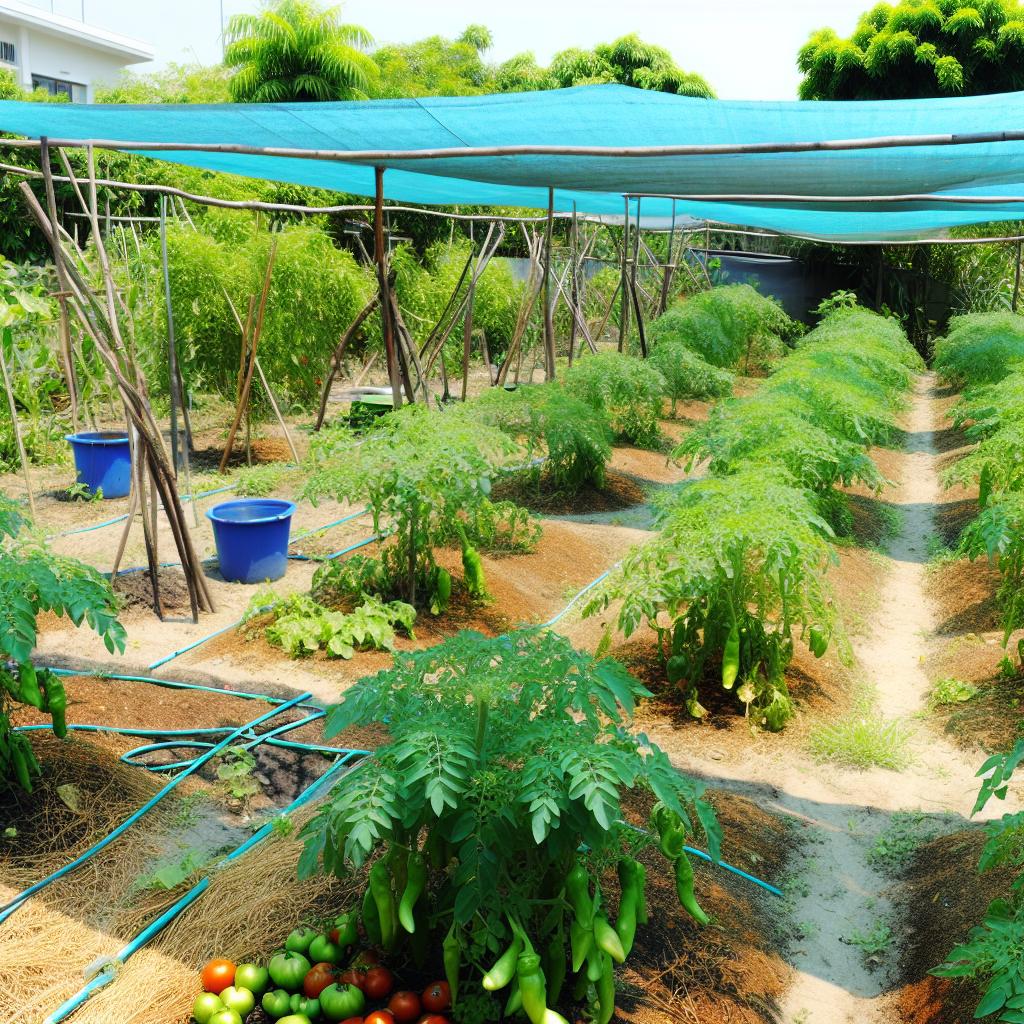Are you tired of struggling to grow a successful vegetable garden in a hot climate? Look no further! In this article, we will explore the best tips and tricks for cultivating a thriving garden in even the most scorching of conditions. Whether you’re a seasoned gardener or a beginner, we’ve got you covered with expert advice and practical strategies to help you achieve a bountiful harvest. Say goodbye to wilted plants and hello to a flourishing garden – let’s get started!
Table of Contents
- Choosing the Right Vegetables for Hot Climates
- Understanding Soil and Watering Needs in Hot Climates
- Utilizing Shade and Mulch to Protect Your Plants
- Implementing Proper Timing and Maintenance for Hot Climate Gardens
- Q&A
- In Conclusion

Choosing the Right Vegetables for Hot Climates
When it comes to growing a successful vegetable garden in a hot climate, choosing the right vegetables is key. Here are some tips to help you select the best vegetables for your hot climate garden:
**Consider Heat-Tolerant Varieties:** Look for vegetable varieties that are specifically bred to withstand high temperatures. These varieties are more likely to thrive in hot climates and produce a bountiful harvest.
**Choose Vegetables with Shorter Growing Seasons:** Opt for vegetables that have shorter growing seasons, as they are more likely to mature before the intense heat sets in. This will help you avoid the risk of your vegetables bolting or becoming stressed from the heat.
**Select Vegetables that Thrive in Full Sun:** In hot climates, it’s important to choose vegetables that can handle full sun exposure. Look for vegetables that are known for their ability to thrive in hot, sunny conditions.
In addition to these tips, it’s important to provide your hot climate vegetable garden with plenty of water and shade to help your plants beat the heat. By choosing the right vegetables and providing them with the proper care, you can grow a successful vegetable garden in even the hottest of climates.

Understanding Soil and Watering Needs in Hot Climates
When it comes to growing a successful vegetable garden in a hot climate, understanding the soil and watering needs is crucial. The right soil and watering practices can make all the difference in the health and productivity of your plants. Here are some tips to help you navigate the challenges of gardening in a hot climate:
Soil Needs
Hot climates can present unique challenges when it comes to soil. Here are some key considerations for understanding soil needs in hot climates:
- Choose well-draining soil to prevent waterlogging and root rot.
- Consider adding organic matter to improve soil structure and water retention.
- Test your soil pH and make adjustments as needed to ensure optimal growing conditions for your vegetables.
Watering Needs
Proper watering is essential for the success of your vegetable garden in a hot climate. Here are some tips to help you meet the watering needs of your plants:
- Water deeply and infrequently to encourage deep root growth and drought tolerance.
- Consider using mulch to help retain soil moisture and reduce evaporation.
- Water in the early morning or late evening to minimize water loss from evaporation.

Utilizing Shade and Mulch to Protect Your Plants
One of the biggest challenges of growing a successful vegetable garden in a hot climate is protecting your plants from the intense heat and sun. Utilizing shade and mulch can be effective strategies to help your plants thrive in these conditions. By providing shade and using mulch, you can help regulate the temperature of the soil, reduce water evaporation, and protect your plants from sunburn.
Shade can be created using various methods such as using shade cloth, planting taller plants nearby to provide natural shade, or using umbrellas or other structures to block the sun. Mulch, on the other hand, can help retain moisture in the soil, suppress weeds, and regulate soil temperature. When using mulch, it’s important to choose the right type for your specific climate and plants. Organic mulches like straw, wood chips, or compost can also improve soil fertility as they break down over time.
In addition to providing shade and using mulch, it’s important to choose heat-tolerant plant varieties, water your garden regularly, and consider using drip irrigation to minimize water loss. With these strategies in place, you can create a thriving vegetable garden even in the hottest of climates.
Implementing Proper Timing and Maintenance for Hot Climate Gardens
When it comes to growing a successful vegetable garden in a hot climate, proper timing and maintenance are key. With the right strategies in place, you can ensure that your garden thrives even in the hottest of conditions. Here are some tips to help you implement proper timing and maintenance for your hot climate garden:
- Choose the right plants: Opt for heat-tolerant vegetable varieties that are well-suited for hot climates, such as tomatoes, peppers, eggplants, and okra.
- Watering schedule: Water your garden in the early morning or late evening to minimize evaporation and ensure that the plants have enough moisture to withstand the heat.
- Mulching: Apply a layer of mulch around your plants to help retain soil moisture, regulate soil temperature, and suppress weeds.
By following these tips and staying on top of maintenance tasks such as weeding, pruning, and fertilizing, you can create an environment that supports the growth of a thriving vegetable garden in a hot climate.
Q&A
**Q: What are the best vegetables to grow in a hot climate?**
A: There are several vegetables that thrive in hot climates, such as tomatoes, peppers, eggplant, okra, and sweet potatoes.
**Q: How can I protect my vegetable garden from the intense heat?**
A: Using shade cloth, mulch, and regular watering can help protect your plants from the intense heat in a hot climate.
**Q: What are some tips for watering a vegetable garden in a hot climate?**
A: It’s important to water deeply and infrequently, preferably in the early morning or late evening to minimize evaporation.
**Q: How can I improve the soil quality in a hot climate to ensure successful vegetable growth?**
A: Adding organic matter, such as compost or aged manure, can help improve soil quality and retain moisture in a hot climate.
**Q: What are some natural pest control methods for a vegetable garden in a hot climate?**
A: Using companion planting, beneficial insects, and natural repellents can help control pests in a hot climate without the use of harmful chemicals.
**Q: How can I extend the growing season for my vegetable garden in a hot climate?**
A: Utilizing shade structures, planting heat-tolerant varieties, and practicing succession planting can help extend the growing season in a hot climate.
In Conclusion
We hope this article has provided you with valuable insights and tips on how to grow a successful vegetable garden in a hot climate. By following the advice and implementing the strategies mentioned, you can overcome the challenges of high temperatures and still enjoy a bountiful harvest of fresh, homegrown produce. Remember to stay consistent with watering, provide adequate shade and protection, and choose the right varieties of vegetables for your specific climate. With a little patience and dedication, you can create a thriving vegetable garden that will bring joy and satisfaction for years to come. Happy gardening!

